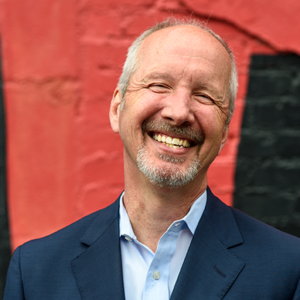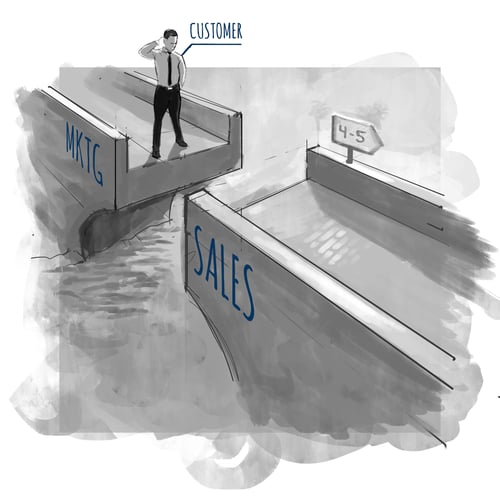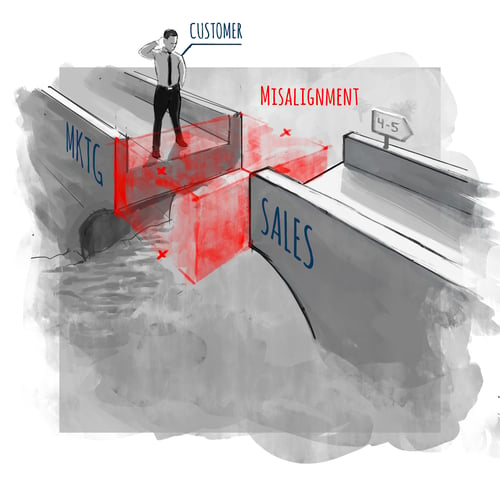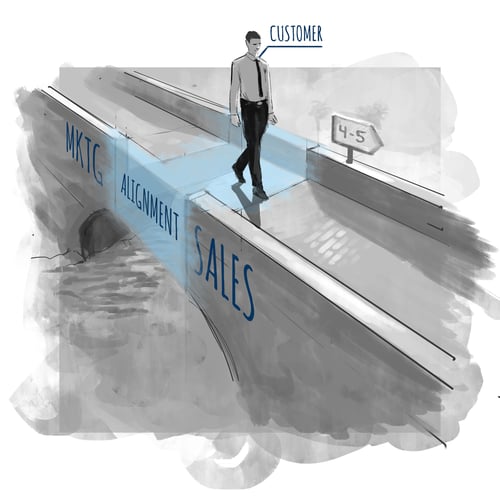
Sean Doyle
Sean is a principal at FitzMartin, and our leading mind and voice on sales and marketing strategy. Sean is particularly adept at applying the science of behavior change to the art of sales and marketing. It’s an approach that he and FitzMartin have developed over thousands of client engagements since 1992.
Never miss a post
Subscribe below to receive blog updates.
Eleanor, a key marketing executive at a middle-market company in the Southeast, sat at her desk and studied the numbers. Over the past few years, pressure had been ramping up, and leadership team meetings were an hour of the week that she dreaded. More questions, more demands for answers, more weight on her shoulders. The pressure to produce the revenue that the company needed to hit its quarterly number was unrelenting.
The sales force had been active; they had received the required, if not always wanted, coaching. They had hired an ad agency to produce sales tools, and those tools were beautiful. However, nothing was changing.
She had pushed so hard. Prospects knew the firm; the firm knew the decision-makers. It felt like success came only when salespeople bludgeoned their way in the doors of those prospects. But you do what you have to do, right?
The problem was, even after the presentations and after the advertising, the deals were still not closing. Why? Eleanor felt there had to be a better way.

The pursuit of repeatable results
In 2002, I had been in business for about 15 years, and we had a good shop. We were able to help clients. My firm had grown from a craft-based, design-based company into one that helped with marketing strategy and sales planning. I went to the sales-training schools and learned the sales craft that my clients had learned. I got the coaching and suffered the same pressures that my client’s sales team experienced. That … that changed my point of view.
We began to map out annual marketing budgets, but we did it with an eye toward sales effectiveness. No more singular focus on craft and marketing thinking. Instead, we began to focus seriously on critical measurements and ROI.
But still, I wondered how we obtained great results when a campaign worked and what was wrong when we failed. I wanted repeatable and assured results. More importantly, my clients expected it!
About this time, everything changed. Professionally, I knew what I was doing. However, what was the quantitative basis upon which I was making these recommendations? Could I find a framework that allowed my firm to deliver consistent and repeatable results? I didn’t have a perfect answer. At this point, I had worked on more than 5,000 engagements. With that much experience, you see the patterns; you recognize what works and what doesn’t. I still didn’t understand why, but then something interesting happened. I was introduced to a science project!
James Prochaska and Carlo DiClemente were three scientists who studied behavioral change. They called it the Transtheoretical Model of Behavior Change. Really fancy name. Here was a framework that explained how somebody moved from one type of behavior to another.
So hold on ...
What I just described is what many call a CDJ or Consumer Decision Journey. True. However, this new framework offered a CDJ built on a platform of science … not the ideas of any specific consulting firm or the CMO or SVP of Sales. It’s a third party we can all agree to follow. And by all, I mean marketing, sales, the executive team and the agency. Well, if we all agree that we want marketing and sales alignment that yields better ROI for your sales and marketing investment.

The Aha! moment came when I realized that effective and honest sales and marketing is, at its root, about helping prospects move from one pattern of buying behavior to another; you want them to go from buying an inferior product or a service to buying your product or service. Sales is converting an existing pattern of behavior to a new and better pattern.
It’s not manipulation.
It’s not persuasion.
It’s helping someone on their own schedule, on their own time, meet their own needs—not my needs as a salesperson.
Why marketing and sales investments fail
One step deeper than the consumer decision journey, our scientists helped me to see the most significant insight of them all—The Nine Processes. Huh? The CDJ sure, but what is this process talk?
Prochaska and DiClemente uncovered another truth in their work. If you look at the six stages that are common to all behavior change, from unaware to advocacy, the significant insight is this: There are nine “processes” that are common to all change, and those processes are NOT interchangeable.
For example, the process for creating awareness is what science calls “consciousness raising.” This process is effective early in the buying decision but doesn’t work anywhere else. Likewise, the processes that work when a prospect is closer to making a decision are ineffective, and even detrimental, if used early in the buying journey.
See if this sounds familiar. You spend a lot of your marketing budget creating awareness (consciousness raising), but you get frustrated that you are not closing more deals and generating revenue from your investment. The problem is that you are expecting the wrong thing from marketing designed to create awareness. Awareness does not close deals. Awareness creates, well, awareness.
The science states that once a prospect is aware of a problem or how your company can solve the problem, they move to a stage called Consideration. People who are considering a change do not buy, they explore and learn—so why do we get frustrated with the lack of revenue?
Why, as marketers, do we invest in creating more awareness for prospects who know us, when the problem is not awareness. Recall Eleanor’s story. Her business did NOT have an awareness problem. If we had advised her to use tools that raise awareness, the effort would have failed. Again.
However, let’s come back to her story in a moment.
Including awareness tools, our inspired scientists share a set of nine processes that each are powerful and effective but only at certain stages of the behavior-change process. If you use awareness tools when your prospect* is closer to making a decision and needs the help that comes when we use the process called “Rational Re-evaluation,” well, your effort fails. This is even more true (and interesting) later in the sales cycle when powerful processes called “Positive Substitution” and “Environmental Controls” come into play. You have to use the correct process at the precise time, based on each prospect’s need.
*I think we can agree that we are talking people, right? Not this abstract thing we call a target or prospect.
We’ve just introduced to four of the nine processes, at least in name. You can learn more about all nine processes, and the best use of each, later but what I desire that you see now is this: The science of this framework—the truth—is the basis for repeatable and consistent results.
It is straightforward, profoundly simple. Understand the CDJ, sure, but more so—know the processes that help humans change their behavior, and apply those processes to your sales and marketing efforts. Know what the nine processes are and understand when to use them, and you will unlock a powerful tool.
The misuse of the processes—presenting the wrong information at the wrong stage of the sales cycle—is why your investments did not work; it’s why what looks like great marketing often fails. Technically, it’s not that the marketing did not work; it’s only that it was misapplied to the sales problem you were facing. Early-stage sales prospects are not moved by marketing and sales tools that are effective at a later stage. Late-stage prospects are not moved by marketing tools that worked perfectly to create awareness.
Business is an exchange relationship, and victory should be measured as such.
Eleanor was my largest client. The day she called and said, “We have a list of fifteen hundred prospects. These prospects would be highly valuable to us, but they’re very hard to reach. In fact, we’ve worked with three agencies before you, and each of them has failed. Now we would like you to take this job.”
Well. That was a little scary.
You don’t want to hear your largest client say everyone else has tried and failed, and now it’s your turn.
I had no idea if she or we would come out of this engagement in one piece.
And then I thought: Why not? Let’s try this. Put it to the test. We are good, and these nine processes provide clarity. So we did our first sales and marketing audit based on what we call Cognitive Marketing. (In this audit, we apply behavioral science to the marketing and sales process, looking for barriers to sales and gaps from the point of view of the prospect. The audit reveals where money is misspent on ineffective tools and where things are clicking along.) So we audited all that Eleanor had been doing in both marketing and sales and assigned everything to a stage of the CDJ to understand what processes she was using and when.
What we saw was the weight of investment, in both time and money, was concentrated very early in the sales cycle. Later stages, helping stage 2 prospects convert to stage 3 or stage 3 prospects move to stage 4, had no support. Most egregious, stage 4 prospects (those asking for help to buy) had no support in helping them move to stage 5, a buyer. Marketing had not considered these late-stage buyers’ needs. This was a tremendous insight, and we took it to Eleanor immediately.
What happened?
Eleanor approved an investment, based on science, that looked very different from past efforts. We built late-stage sales tools and coordinated extensively with the sales force. The net result was impressive—$380,000,000 in new relationships. Three hundred and eighty million dollars of deals in four weeks. ROI of $1:$419, marketing spend to deals closed. That is business. That is marketing the way it should look.
She never told us, but I would guess that the next leadership team meeting was a good one for Eleanor. One where she sat taller and had earned a bit more respect from her peers. The CFO even bought in. We repeated the program for 13 years. Now THAT is behavior change and a deal closed!

For me, it was the Aha! moment that changed the rest of my career. More importantly, it became the core of our business—how we help our clients. It is game-changing. It’s revolutionary.
Now, we guide our clients through these processes, how to use them. It creates a framework where you can look at everything you’re doing in marketing and in sales. You can align all of your activities to one truth. The net result is lower customer acquisition costs, more effective marketing and better results from your sales investment. Our clients can manage marketing more effectively, whether it’s an internal department or an agency; you’ll be able to vet whether or not they know what they’re doing.
Most of our clients have worked with an agency before. Those agencies have failed, and our clients have been frustrated, often coming to believe that marketing doesn’t work. I see that reflected in a couple of different ways. When it comes to marketing, they don’t invest the money necessary to be successful. They don’t emphasize it enough. Marketing doesn’t sit at the executive table.
Now, I have never met an agency that used or understood the nine processes this way; perhaps they exist … probably do. Many use the CDJ, and most spend time and have deep skills in early-stage tools. Most agencies know how to create awareness.
We guide our clients to a more effective budgeting model that considers the whole buying cycle, and we work with sales to learn and communicate what to do and when. The results are more deals closed with less reliance on brute-force sales. And that is a result everyone can appreciate.

